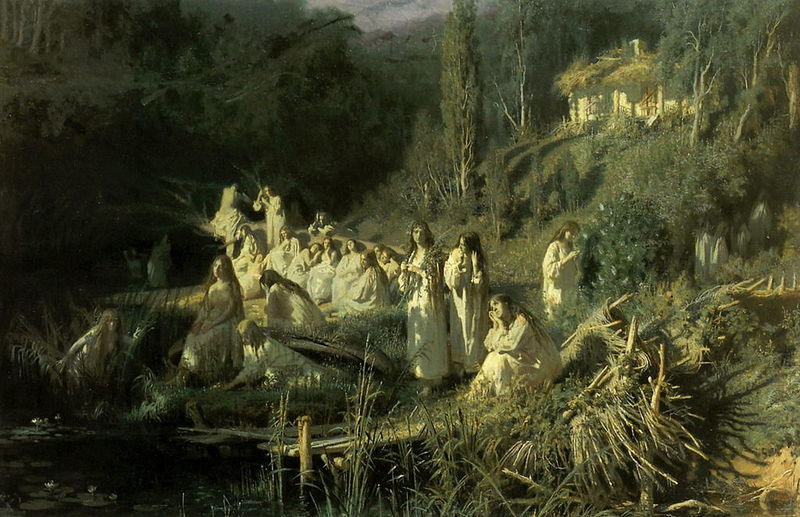
Rusalka by daekazu on deviantart
https://www.deviantart.com/daekazu/art/Rusalka-187551820
===================
==============
=========
The Russian Mermaid ...
She is as dangerous as she is beautiful
Rusalka or
Pusalka is commonly described as a water nymph
..
The Rusalka is a female spirit in Russian / Slavic folklore and their equivalent of a mermaid. though she has two leg's insted of a finned tail and in some versions can walk on land and even climb tree's..
She has different names in various cultures:
rusalka (in East Slavic cultures)
vila (Czech, Slovak),
wiła (Polish).
According to most accounts the rusalki were a type of fish-women, who lived
at the bottom of rivers and lake's.
In some legends she would leave her watery home late at night together with other Rusalki she would walk out
to the bank and dance in meadows. If they saw handsome men, they would
enchant them with songs and dancing, mesmerize them, then lead them
away to the river and to their inevitable death.

Art by Anna Vinogradova Kransndar 1975
=========================
A Rusalka most often appears as a beautiful young women, she will site by the shore of a lake usually coming her hair or sometimes singing this is done as a means to lure in her prey..
In some version's she is a type of water spirit in other's she is a young woman that was ether murdered by her lover of who committed suicide by drowning due to an unhappy
marriage or who were violently drowned
against their will (especially after becoming pregnant with unwanted
children), and now must live out their time on Earth as rusalki.
However,in some Slavic versions not all rusalki encounters were linked with death from water
It is accounted by most stories that the soul of a young woman who had died in or near a river or a lake would come back to haunt that waterway.
Though this version of a
rusalka is not invariably malevolent or evil, and would be allowed to rest in
peace if her death is avenged.
========
In some versions she has green sea week like hair....
================
Her main purpose is, however, to lure
young men, seduced by either her looks or her voice, (Similar to a Siren or a Succubus) into the depths of
the waterways where she would entangle their feet with her long hair and submerge them. Her body would instantly become very slippery
and not allow the victim to cling on to her in order to reach the
surface.

======
She would then wait until the victim had drowned, or, on some
occasions, tickle them to death, as she laughed.
It is also believed, by a few accounts, that rusalki can change their
appearance to match the tastes of men they are about to seduce although a rusalka is generally considered to represent universal
beauty, therefore is highly feared yet respected in Slavic culture.
===================

Ivan Kramskoi,
The Mermaids, 1871
======
In some of the older stories the Rusalka was a symbol of fertility and not consider
evil in the old pagan beliefes
They came out of the water in the
spring to transfer life-giving moisture to the fields and thus helped
nurture the crops.
=====
=======================
Celebrations: Rusalka Week..
=======================
The Rusalki are believed to be at their most dangerous during the Rusalka Week
in early June. At this time, they were supposed to have left their
watery depths in order to swing on branches of birch and willow trees by
night. Swimming during this week was strictly forbidden, lest these mermaids
would drag a swimmer down to the river bed.
 Rusalka
Rusalka by Ivan Bilibin - 1934
===========================================
A common feature of the
celebration of Rusalnaya was the ritual banishment or burial of the
rusalki at the end of the week, which remained as entertainment in
Russia, Belarus, and Ukraine until the 1930s
=====
Other mediums ..
============
The Rusalka trilogy of novels by C. J. Cherryh feature and revolve around a rusalka named Eveshka.
Rusalka is an opera by Alexander Dargomyzhsky. - 1856
"Rusalka" is a poem by Mikhail Lermontoy 1831.
Nikolai Medtner's Third Piano Concerto is based on Mikhail Lermontov's ballad.
A Rusalkas is the main character in "The Surface Breaks", a YA novel and retelling of
Hans Christian Andersen's "The Little Mermaid" by Louise O'Neill.
Rusalkas appear as monsters in the Action Role playing game The Incredible Adventures of Van Helsing.
"
The Last Wish " by Andrzej Sapkowski, a Polish novel from the Witcher series, in which Geralt briefly encounters a Rusalka that has fallen in love with a cursed man.
"Fatima Rusalka", a single by alternative metal band Alesana ..
There are many many other examples of Rusalka in modern media bedside's the one's i mentioned here.. :)
.================
===============
==============









